5 Amazing Viviparous Animals
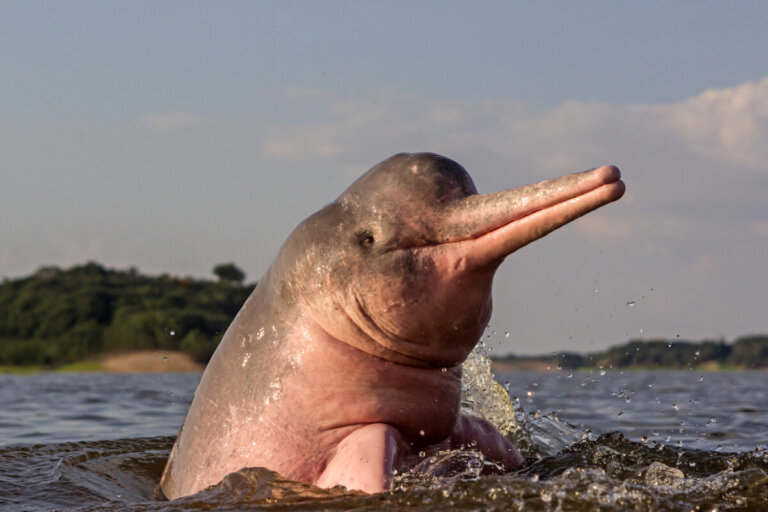

Reviewed and approved by the biologist Georgelin Espinoza Medina
The embryos of viviparous animals develop inside the mother’s body. Although most females with this mode of reproduction have a placenta and umbilical cord, there are species that lack these structures or have some other similar ones. Do you want to learn about five amazing viviparous animals? Let’s get to it!
The features of viviparous animals
Viviparity is a mode of reproduction present in most mammals. However, some animals belonging to the following classes also present this type of reproduction:
- Fish
- Reptiles
- Amphibians
Nature has always surprised us with its diversity and unique adaptations. According to a publication in the journal Biological Reviews, pregnancy in mammals evolved only once. In contrast, it has occurred 22 times in fish, 8 times in amphibians, and 115 times in scaly reptiles.
In addition, other characteristics of this type of reproduction are the following:
- Generally, they possess a placenta and an umbilical cord: The first is an organ of membranous and soft structure, which surrounds the uterus of pregnant females. It provides an abundant and powerful blood supply. The second is a duct inside the uterus through which the fetus receives nutrients and allows the elimination of wastes.
- The duration of gestation or pregnancy is variable: The time between fertilization and parturition in viviparous animals depends on the species.
- The uterus increases in size as the zygote develops: During this phase, the body undergoes a series of changes, both internal and external, to naturally prepare the female for the process.
- Most viviparous animals are quadrupeds: Those that have four limbs to stand upright, move, and walk.
- Most females have a maternal instinct: Mammalian females usually have a strong and deep maternal instinct to nurture and protect their offspring until they’re able to fend for themselves. The female will recognize precisely the right moment for this.
- These animals carry out internal fertilization: I.e., it occurs inside the mother’s body.
Not only do these animals share these characteristics, but their type of viviparous reproduction can also be classified into three major groups. Keep reading to learn a little about these conditions!
Types of reproduction of viviparous species
Within the wide variety of viviparous animals in nature, several methods of reproduction and gestation can be distinguished. According to a review published in Reproductive Biology, they’re as follows:
- Hemotrophic viviparity: A method of reproduction that’s notable for the presence of a placental system in the uterus of the gestating female or similar structures, allowing for the exchange of nutrients and wastes between the mother and the embryos. Nutrients are supplied through the bloodstream, which gives rise to its name. This process ensures an adequate and sustainable environment, as well as protection and nutrition for the embryos during their development.
- Histotrophic viviparity: This is a type of reproduction in which the embryos develop inside the female’s body and receive nutrients directly from the secretions produced by the glands of the uterus or the maternal oviduct. Unlike hemotrophic viviparity, where nutrients are provided through the mother’s circulatory system, in this case, the embryos rely on nutritional substances released by the cells of the uterine lining.
That said, now let’s discover five viviparous animal species with amazing characteristics.
Discover five viviparous animals with amazing characteristics
As we explained previously, most mammals reproduce viviparously. These kinds of vertebrates aren’t the only ones, as we can find species with these characteristics in almost all groups of living beings, such as fish, amphibians, and even reptiles. On this occasion, we’ll present five amazing species of viviparous animals.
1. Humpback whale (Megaptera novaeangliae)
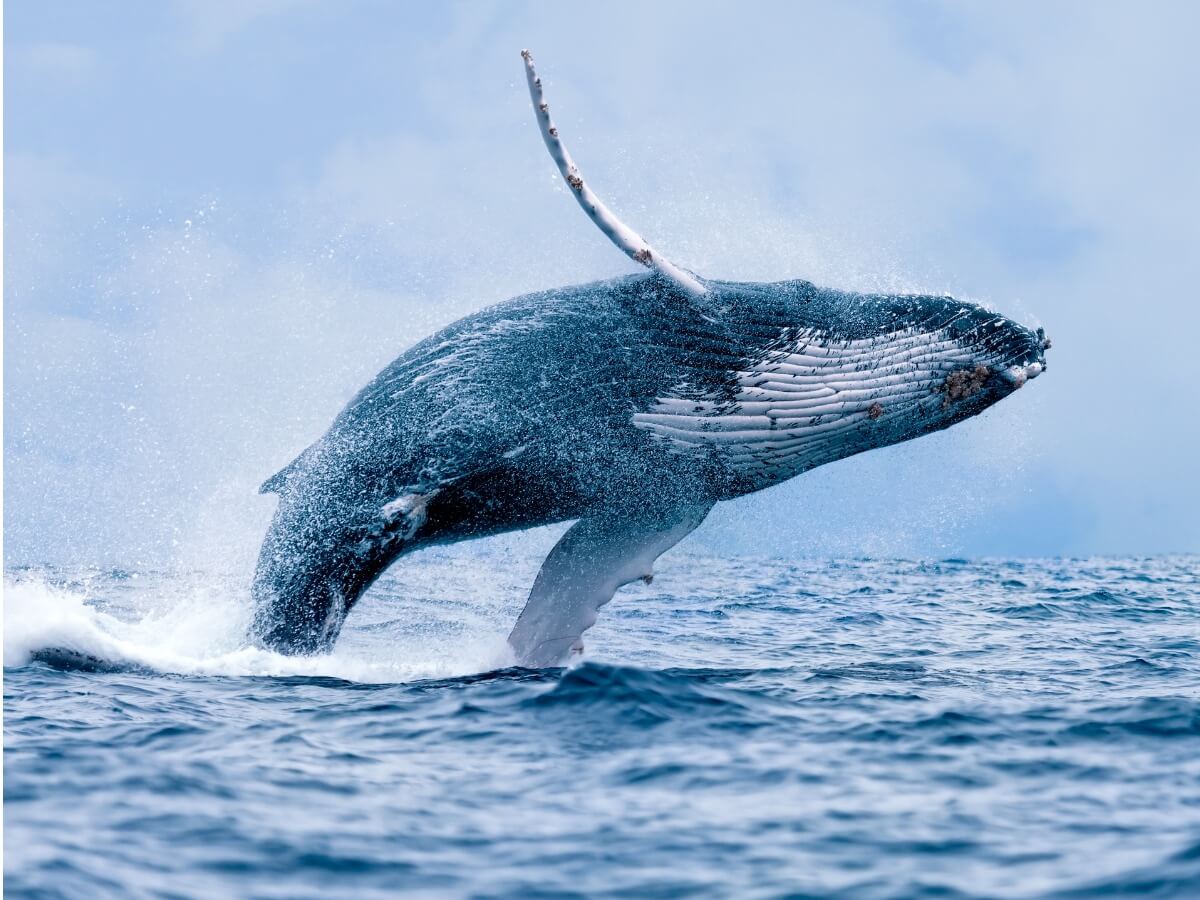
The humpback whale belongs to the group of mystecite cetaceans and is part of the family Balaenopteridae, which includes the rorquals.
This species stands out as one of the most imposing rorquals, with adult specimens reaching sizes of 39 to 52 feet and weighing approximately 79,000 feet. Its physical appearance is unmistakable due to its long pectoral fins and distinctive knobbly head.
According to a publication in the Encyclopedia of Marine Mammals, this whale is recognized by the complex songs of the males to attract females and its aerial behaviors.
Reproduction
After successful copulation, the female goes through a gestation period that lasts approximately 11 months. During this time, the embryo develops in her uterus. Through the placenta, it receives nutrients and oxygen.
Often, humpback whales choose sheltered, quiet areas to give birth in order to minimize the exposure of their newborn calves to the dangers of the ocean. Once born, calves are vulnerable and dependent on their mothers for survival. Breastfeeding is critical to their early growth and development.
Humpback whales have fat-rich milk that provides the energy needed for the calves to grow rapidly and develop a protective blubber layer.
Mothers also teach their calves essential skills, such as the following:
- Swimming
- Breathing
- Diving
The nursing period can last several months. During this time, humpback whales maintain a close bond with their calves.
2. Seahorse (Hippocampus): One of the most amazing viviparous animals
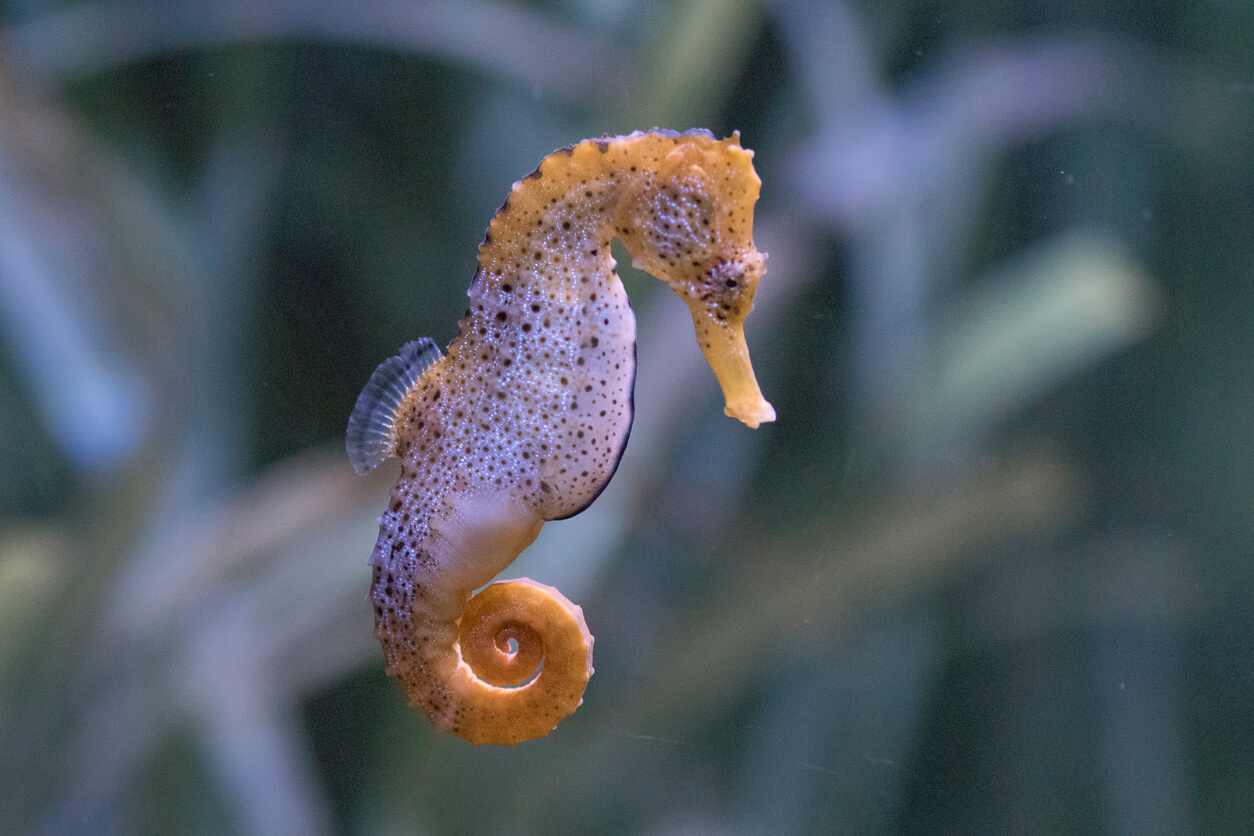
The seahorse is a marine fish that’s part of the family Syngnathidae, which includes the following species :
- Needlefish
- Seahorses
- Sea dragons
Seahorses are encompassed in a single genus, known as Hippocampus, which includes at least 32 species that are distributed all over the planet. For example, in the Mediterranean Sea, it’s possible to find two species of seahorses, namely, the H. hippocampus and the H. guttulatus.
How do seahorses reproduce?
The seahorse has a unique method of reproduction in which it’s the male that takes responsibility for the eggs.
According to information published by the CRAM Foundation, this pouch fulfills a function similar to the uterus of a mammal. After a month, when the embryos have formed, the male releases them to the outside.
In many of the seahorse species that have been studied so far, it has been observed that they’re monogamous during the breeding season.
3. Amazon river dolphin (Inia geoffrensis)
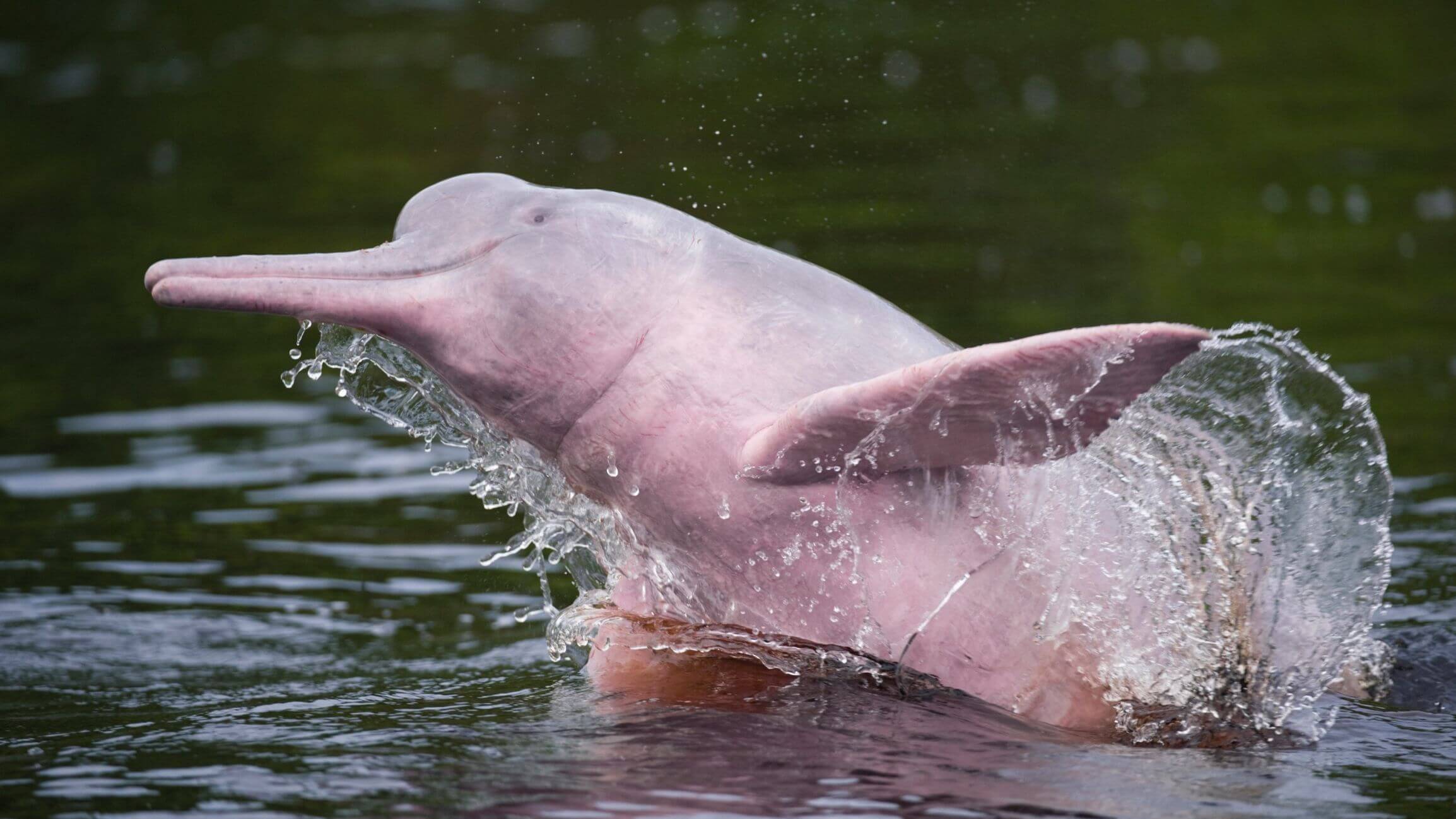
The pink dolphin, native to Amazonian waters, is known for its distinctive pink color that contrasts with its aquatic environment. With a robust body and prominent forehead, this river dolphin shows an innate curiosity toward humans and is famous for its complex social interactions.
A description of the species in National Geographic explains that the reason behind its pink hue isn’t yet fully understood. However, it does point to some possible causes:
- Water temperature
- Adaptation to the river environment
- Provision of capillaries close to the skin
At birth and in its early stages of life, it presents a grayish hue, which lightens during adolescence and then, in adulthood, transforms into the distinctive pinkish hue. This is attributed to the natural wear of the skin throughout their life.
Reproduction
During mating, males use branches and reeds to hit the water surface or even display live turtles as a kind of trophy in order to attract females.
In addition, there’s a fierce rivalry between males, leading to confrontations in which they suffer injuries to their snouts and flippers. In fact, they may even mutilate themselves.
Scars on the males’ bodies become an attractive feature during the mating season. Females find males with more scar tissue attractive, at least during the rutting period.
Copulation takes place through the union of the bellies between both sexes.
The gestation period is estimated to be between 11 and 15 months. Females give birth to a single calf every two to three years. The lactation process lasts for more than a year.
The curious intelligence of the pink dolphin
Most varieties of river dolphins have limited vision due to the turbid waters that constitute their natural habitat. However, the pink dolphin has a more acute vision.
This dolphin stands out for being the most intelligent of all river dolphin species. In this regard, it exhibits a brain capacity that exceeds that of humans by 40%.
As for its diet, the Amazon river dolphin feeds on a variety of 43 species of fish, such as the following:
- Tetras
- Piranhas
- Catfish
- Corvinas
It also supplements its diet with crabs and small turtles.
4. Ring-tailed lemur (Lemur catta)
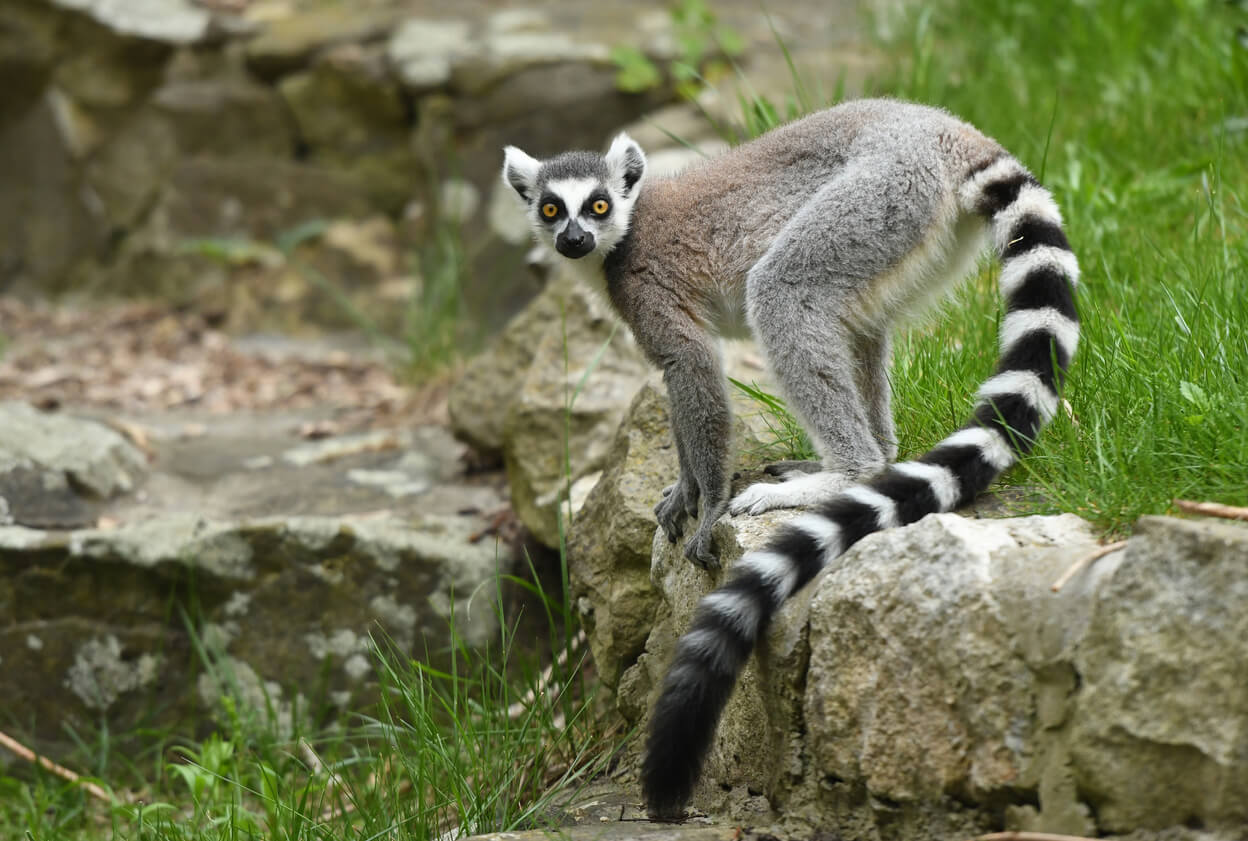
The ring-tailed lemur originates from Madagascar, and its distinguishing feature is its black-and-white tail, which gives it its name. Its back shows shades of grayish brown, contrasting with its whitish belly.
Despite having relatively large legs, these are smaller than those of other tree-dwelling lemur species.
As adults, these lemurs reach a body length of 15 to 18 inches, with an average weight of nearly 5 pounds. Their tails, which are longer than their bodies, range from 22 to 25 inches.
How does the ring-tailed lemur reproduce?
The Jeréz Zoobotánico Jeréz website, from the Jeréz City Council, indicates that during the reproductive season, all females of the group go into heat. Males engage in energetic fights, which are ritualized and occur regardless of the existing hierarchy in the group.
One or more males impregnate the females. During this process, they remain standing. After approximately four and a half months, it’s common for one pup to be born, although, in exceptional situations, there may be two.
Although in a matter of days, these amazing viviparous animals are able to climb trees, in the first fourteen days, they usually remain clinging to their mother’s belly before moving to her back.
Breastfeeding lasts approximately six months, although they can eat solid food after one month of birth. Sometimes, females support each other in caring for their young and even adopt them if the mother is absent.
Sexual maturity is reached at around one and a half years, although fertilization can occur as early as two years of age. In captivity, these lemurs can live around 20 years, while in the wild, their life expectancy is a little less.
A curious fact about these animals is that males use their scent glands to fight for dominance during the mating season. They fill their tails with pestilent secretions and then wave them in the air to demonstrate power through strong odors.
5. Giant otter (Pteronura brasiliensis)

The last amazing viviparous animal species on our list today is the giant otter. This semi-aquatic mammal has a long, broad body, with an average length of 6 feet and a weight of about 70.5 lbs.
Its coloration is a chocolate-brown hue, which is highlighted by a yellowish patch in the throat area. Its fur is shorter in comparison to that of otter species, which gives it a quite distinctive appearance. In fact, its physical appearance is so unique that, at times, it can be mistaken for another type of animal.
In the book The Sea Otter in Southern Peru (2021), a comparison is made between the sea otter of the Peruvian coasts and the giant otter. The latter has a very peculiar confrontational grunt, which sounds similar to a sneeze. For this reason, it’s recognized as the most communicative and loudest of all otter species.
Reproduction
Females tend to give birth to their young during the dry season. Their estrous cycles extend over 21 days, and their period of sexual activity occurs between the third and tenth day. Giant otters are known to choose mates and form long-lasting bonds.
Gestation lasts between 65 and 70 days. It culminates in the birth of one to five pups, with an average of two. The intervals between births have been reported to range from 21 to 33 months. The young are born with abundant hair for protection and are blind. They open their eyes within a month of birth.
Females give birth in burrows that they build before the process and that their family group defends. These dens are usually located near riverbanks and in areas suitable for fishing.
Throughout the rearing process, males play an active role in caring for the young. This reinforces strong family bonds. Even older siblings participate in this process.
The hatchlings usually open their eyes around one month after birth, start walking on the fifth day, and are able to swim properly after 14 weeks. They stop suckling at nine months and begin hunting on their own soon after.
The advantages of viviparous reproduction
After this tour of five viviparous animals with amazing characteristics, you’ve surely realized that viviparity offers a number of crucial advantages that have influenced the evolution of several species.
In a world where predators lurk, this type of reproduction provides shelter for developing embryos inside the mother’s body. Predators have less access to the developing offspring in comparison to the case of eggs exposed to the external environment. This system reduces the risk of being eaten at an early stage of development and increases the chances of survival.
Another key advantage is the ability to withstand adverse weather conditions, especially in cold climates. By keeping the embryos inside the maternal body, a more constant and warmer thermal environment is ensured.
This is important in places where egg laying would be too risky, as the eggs can’t regulate their temperature effectively. In addition, eggs deposited in the environment are exposed to a number of hazards, such as mechanical damage or desiccation.
This evolutionary adaptation in reproduction has allowed for the survival and reproductive success of amazing viviparous animals in a variety of challenging environments.
The embryos of viviparous animals develop inside the mother’s body. Although most females with this mode of reproduction have a placenta and umbilical cord, there are species that lack these structures or have some other similar ones. Do you want to learn about five amazing viviparous animals? Let’s get to it!
The features of viviparous animals
Viviparity is a mode of reproduction present in most mammals. However, some animals belonging to the following classes also present this type of reproduction:
- Fish
- Reptiles
- Amphibians
Nature has always surprised us with its diversity and unique adaptations. According to a publication in the journal Biological Reviews, pregnancy in mammals evolved only once. In contrast, it has occurred 22 times in fish, 8 times in amphibians, and 115 times in scaly reptiles.
In addition, other characteristics of this type of reproduction are the following:
- Generally, they possess a placenta and an umbilical cord: The first is an organ of membranous and soft structure, which surrounds the uterus of pregnant females. It provides an abundant and powerful blood supply. The second is a duct inside the uterus through which the fetus receives nutrients and allows the elimination of wastes.
- The duration of gestation or pregnancy is variable: The time between fertilization and parturition in viviparous animals depends on the species.
- The uterus increases in size as the zygote develops: During this phase, the body undergoes a series of changes, both internal and external, to naturally prepare the female for the process.
- Most viviparous animals are quadrupeds: Those that have four limbs to stand upright, move, and walk.
- Most females have a maternal instinct: Mammalian females usually have a strong and deep maternal instinct to nurture and protect their offspring until they’re able to fend for themselves. The female will recognize precisely the right moment for this.
- These animals carry out internal fertilization: I.e., it occurs inside the mother’s body.
Not only do these animals share these characteristics, but their type of viviparous reproduction can also be classified into three major groups. Keep reading to learn a little about these conditions!
Types of reproduction of viviparous species
Within the wide variety of viviparous animals in nature, several methods of reproduction and gestation can be distinguished. According to a review published in Reproductive Biology, they’re as follows:
- Hemotrophic viviparity: A method of reproduction that’s notable for the presence of a placental system in the uterus of the gestating female or similar structures, allowing for the exchange of nutrients and wastes between the mother and the embryos. Nutrients are supplied through the bloodstream, which gives rise to its name. This process ensures an adequate and sustainable environment, as well as protection and nutrition for the embryos during their development.
- Histotrophic viviparity: This is a type of reproduction in which the embryos develop inside the female’s body and receive nutrients directly from the secretions produced by the glands of the uterus or the maternal oviduct. Unlike hemotrophic viviparity, where nutrients are provided through the mother’s circulatory system, in this case, the embryos rely on nutritional substances released by the cells of the uterine lining.
That said, now let’s discover five viviparous animal species with amazing characteristics.
Discover five viviparous animals with amazing characteristics
As we explained previously, most mammals reproduce viviparously. These kinds of vertebrates aren’t the only ones, as we can find species with these characteristics in almost all groups of living beings, such as fish, amphibians, and even reptiles. On this occasion, we’ll present five amazing species of viviparous animals.
1. Humpback whale (Megaptera novaeangliae)

The humpback whale belongs to the group of mystecite cetaceans and is part of the family Balaenopteridae, which includes the rorquals.
This species stands out as one of the most imposing rorquals, with adult specimens reaching sizes of 39 to 52 feet and weighing approximately 79,000 feet. Its physical appearance is unmistakable due to its long pectoral fins and distinctive knobbly head.
According to a publication in the Encyclopedia of Marine Mammals, this whale is recognized by the complex songs of the males to attract females and its aerial behaviors.
Reproduction
After successful copulation, the female goes through a gestation period that lasts approximately 11 months. During this time, the embryo develops in her uterus. Through the placenta, it receives nutrients and oxygen.
Often, humpback whales choose sheltered, quiet areas to give birth in order to minimize the exposure of their newborn calves to the dangers of the ocean. Once born, calves are vulnerable and dependent on their mothers for survival. Breastfeeding is critical to their early growth and development.
Humpback whales have fat-rich milk that provides the energy needed for the calves to grow rapidly and develop a protective blubber layer.
Mothers also teach their calves essential skills, such as the following:
- Swimming
- Breathing
- Diving
The nursing period can last several months. During this time, humpback whales maintain a close bond with their calves.
2. Seahorse (Hippocampus): One of the most amazing viviparous animals

The seahorse is a marine fish that’s part of the family Syngnathidae, which includes the following species :
- Needlefish
- Seahorses
- Sea dragons
Seahorses are encompassed in a single genus, known as Hippocampus, which includes at least 32 species that are distributed all over the planet. For example, in the Mediterranean Sea, it’s possible to find two species of seahorses, namely, the H. hippocampus and the H. guttulatus.
How do seahorses reproduce?
The seahorse has a unique method of reproduction in which it’s the male that takes responsibility for the eggs.
According to information published by the CRAM Foundation, this pouch fulfills a function similar to the uterus of a mammal. After a month, when the embryos have formed, the male releases them to the outside.
In many of the seahorse species that have been studied so far, it has been observed that they’re monogamous during the breeding season.
3. Amazon river dolphin (Inia geoffrensis)

The pink dolphin, native to Amazonian waters, is known for its distinctive pink color that contrasts with its aquatic environment. With a robust body and prominent forehead, this river dolphin shows an innate curiosity toward humans and is famous for its complex social interactions.
A description of the species in National Geographic explains that the reason behind its pink hue isn’t yet fully understood. However, it does point to some possible causes:
- Water temperature
- Adaptation to the river environment
- Provision of capillaries close to the skin
At birth and in its early stages of life, it presents a grayish hue, which lightens during adolescence and then, in adulthood, transforms into the distinctive pinkish hue. This is attributed to the natural wear of the skin throughout their life.
Reproduction
During mating, males use branches and reeds to hit the water surface or even display live turtles as a kind of trophy in order to attract females.
In addition, there’s a fierce rivalry between males, leading to confrontations in which they suffer injuries to their snouts and flippers. In fact, they may even mutilate themselves.
Scars on the males’ bodies become an attractive feature during the mating season. Females find males with more scar tissue attractive, at least during the rutting period.
Copulation takes place through the union of the bellies between both sexes.
The gestation period is estimated to be between 11 and 15 months. Females give birth to a single calf every two to three years. The lactation process lasts for more than a year.
The curious intelligence of the pink dolphin
Most varieties of river dolphins have limited vision due to the turbid waters that constitute their natural habitat. However, the pink dolphin has a more acute vision.
This dolphin stands out for being the most intelligent of all river dolphin species. In this regard, it exhibits a brain capacity that exceeds that of humans by 40%.
As for its diet, the Amazon river dolphin feeds on a variety of 43 species of fish, such as the following:
- Tetras
- Piranhas
- Catfish
- Corvinas
It also supplements its diet with crabs and small turtles.
4. Ring-tailed lemur (Lemur catta)

The ring-tailed lemur originates from Madagascar, and its distinguishing feature is its black-and-white tail, which gives it its name. Its back shows shades of grayish brown, contrasting with its whitish belly.
Despite having relatively large legs, these are smaller than those of other tree-dwelling lemur species.
As adults, these lemurs reach a body length of 15 to 18 inches, with an average weight of nearly 5 pounds. Their tails, which are longer than their bodies, range from 22 to 25 inches.
How does the ring-tailed lemur reproduce?
The Jeréz Zoobotánico Jeréz website, from the Jeréz City Council, indicates that during the reproductive season, all females of the group go into heat. Males engage in energetic fights, which are ritualized and occur regardless of the existing hierarchy in the group.
One or more males impregnate the females. During this process, they remain standing. After approximately four and a half months, it’s common for one pup to be born, although, in exceptional situations, there may be two.
Although in a matter of days, these amazing viviparous animals are able to climb trees, in the first fourteen days, they usually remain clinging to their mother’s belly before moving to her back.
Breastfeeding lasts approximately six months, although they can eat solid food after one month of birth. Sometimes, females support each other in caring for their young and even adopt them if the mother is absent.
Sexual maturity is reached at around one and a half years, although fertilization can occur as early as two years of age. In captivity, these lemurs can live around 20 years, while in the wild, their life expectancy is a little less.
A curious fact about these animals is that males use their scent glands to fight for dominance during the mating season. They fill their tails with pestilent secretions and then wave them in the air to demonstrate power through strong odors.
5. Giant otter (Pteronura brasiliensis)

The last amazing viviparous animal species on our list today is the giant otter. This semi-aquatic mammal has a long, broad body, with an average length of 6 feet and a weight of about 70.5 lbs.
Its coloration is a chocolate-brown hue, which is highlighted by a yellowish patch in the throat area. Its fur is shorter in comparison to that of otter species, which gives it a quite distinctive appearance. In fact, its physical appearance is so unique that, at times, it can be mistaken for another type of animal.
In the book The Sea Otter in Southern Peru (2021), a comparison is made between the sea otter of the Peruvian coasts and the giant otter. The latter has a very peculiar confrontational grunt, which sounds similar to a sneeze. For this reason, it’s recognized as the most communicative and loudest of all otter species.
Reproduction
Females tend to give birth to their young during the dry season. Their estrous cycles extend over 21 days, and their period of sexual activity occurs between the third and tenth day. Giant otters are known to choose mates and form long-lasting bonds.
Gestation lasts between 65 and 70 days. It culminates in the birth of one to five pups, with an average of two. The intervals between births have been reported to range from 21 to 33 months. The young are born with abundant hair for protection and are blind. They open their eyes within a month of birth.
Females give birth in burrows that they build before the process and that their family group defends. These dens are usually located near riverbanks and in areas suitable for fishing.
Throughout the rearing process, males play an active role in caring for the young. This reinforces strong family bonds. Even older siblings participate in this process.
The hatchlings usually open their eyes around one month after birth, start walking on the fifth day, and are able to swim properly after 14 weeks. They stop suckling at nine months and begin hunting on their own soon after.
The advantages of viviparous reproduction
After this tour of five viviparous animals with amazing characteristics, you’ve surely realized that viviparity offers a number of crucial advantages that have influenced the evolution of several species.
In a world where predators lurk, this type of reproduction provides shelter for developing embryos inside the mother’s body. Predators have less access to the developing offspring in comparison to the case of eggs exposed to the external environment. This system reduces the risk of being eaten at an early stage of development and increases the chances of survival.
Another key advantage is the ability to withstand adverse weather conditions, especially in cold climates. By keeping the embryos inside the maternal body, a more constant and warmer thermal environment is ensured.
This is important in places where egg laying would be too risky, as the eggs can’t regulate their temperature effectively. In addition, eggs deposited in the environment are exposed to a number of hazards, such as mechanical damage or desiccation.
This evolutionary adaptation in reproduction has allowed for the survival and reproductive success of amazing viviparous animals in a variety of challenging environments.
All cited sources were thoroughly reviewed by our team to ensure their quality, reliability, currency, and validity. The bibliography of this article was considered reliable and of academic or scientific accuracy.
- Baumhofer, E. (2017). Lemur catta. Animal Diversity Web. Consultado el 4 de septiembre del 2023. https://animaldiversity.org/accounts/Lemur_catta/
- Clapham, P. J. (2018). Humpback whale: Megaptera novaeangliae. In Encyclopedia of marine mammals (pp. 489-492). Academic Press. https://www.sciencedirect.com/science/article/abs/pii/B9780128043271001540
- Fundación CRAM. (2014). El Caballito de mar. CRAM. Consultado el 17 de agosto de 2023.
https://cram.org/el-caballito-de-mar/#:~:text=El%20caballito%20de%20mar%20posee,incubarlos%20hasta%20su%20completo%20desarrollo. - Kaneko-Ishino, T., & Ishino, F. (2019). Evolution of viviparity in mammals: what genomic imprinting tells us about mammalian placental evolution. Reproduction, Fertility and Development, 31(7), 1219-1227. https://www.publish.csiro.au/RD/RD18127
- Lodé, T. (2012). Oviparity or viviparity? That is the question…. Reproductive biology, 12(3), 259-264. https://www.sciencedirect.com/science/article/abs/pii/S1642431X12000022
- National Geographic (s.f). Ring-Tailed Lemur. National Geographic. Consultado el 22 de agosto del 2023. https://www.nationalgeographic.com/animals/mammals/facts/ring-tailed-lemur
- National Geographic (2021). El delfín rosado del Amazonas se extinguirá en menos de 50 años, revela un estudio. National Geographic en Español. Consultado el 17 de agosto de 2023.
https://www.ngenespanol.com/animales/conoce-al-delfin-rosado/#:~:text=La%20c%C3%B3pula%20se%20realiza%20entre,meses%20de%20mayo%20y%20julio - Pizzaro, J. (2021) La nutria Marina en el Sur de Perú. Asociación para el Desarrollo de las Ciencias Biológicas en el Perú: ADCBP. https://www.researchgate.net/publication/355480857_La_nutria_marina_en_el_sur_del_Peru
- Sexton, C. (2023). Listening to Amazon River dolphins can help us save them. Earth.com. Consultado el 28 de agosto del 2023. https://www.earth.com/news/listening-to-amazon-river-dolphins-can-help-us-save-them/
- Whittington, C. M., Van Dyke, J. U., Liang, S. Q., Edwards, S. V., Shine, R., Thompson, M. B., & Grueber, C. E. (2022). Understanding the evolution of viviparity using intraspecific variation in reproductive mode and transitional forms of pregnancy. Biological Reviews, 97(3), 1179-1192. https://onlinelibrary.wiley.com/doi/full/10.1111/brv.12836
- Zoobotánico Jeréz. (s.f.) Lémur De Cola Anillada. Ayuntamiento de Jeréz. Consultado El 17 de agosto de 2023.
https://www.zoobotanicojerez.com/coleccion-zoologica/relacion-de-especies/lemur-de-cola-anillada-lemur-catta - Zachos, F., & Asher, R. (Eds.). (2018). Mammalian evolution, diversity and systematics. Walter de Gruyter GmbH & Co KG. https://www.researchgate.net/publication/331279411_Mammalian_evolution_diversity_and_systematics_2018_In_Zachos_FE_Ed_Mammalia_Handbook_of_Zoology_editor-in-chief_A_Schmidt-Rhaesa_F_E_ZachosR_J_Asher_de_Gruyter_Berlin-Boston_xi381_pp_24995_ISBN_978-3-
This text is provided for informational purposes only and does not replace consultation with a professional. If in doubt, consult your specialist.








